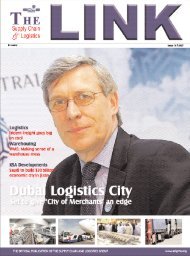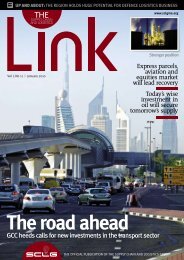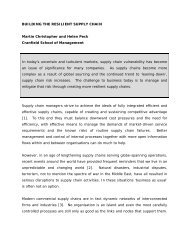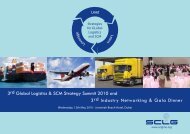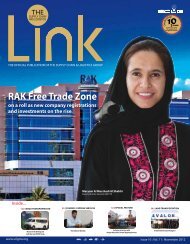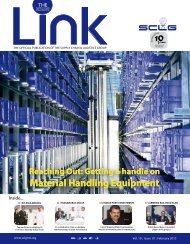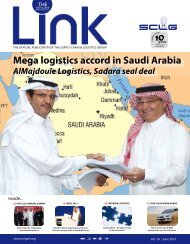Free to Download - SCLG
Free to Download - SCLG
Free to Download - SCLG
- TAGS
- download
- sclg
- sclgme.org
Create successful ePaper yourself
Turn your PDF publications into a flip-book with our unique Google optimized e-Paper software.
OVERVIEW Transport<br />
(transport of fruit and vegetables) ahead<br />
of Rotterdam and Sheerness. The leading<br />
French port is Marseille (0.60 million <strong>to</strong>nnes)<br />
ahead of Dunkirk (0.26 million <strong>to</strong>nnes) and<br />
Port-Vendres (0.17 million <strong>to</strong>nnes). Maritime<br />
freight is seeing a constant rise in volumes.<br />
Despite the current economic difficulties<br />
(rise in petrol prices, etc.), world demand<br />
for container transport has risen still further.<br />
This development has been underpinned<br />
by the expansion of international trade,<br />
the on-going shift from cargo shipments <strong>to</strong><br />
containerised deliveries and the development<br />
of transhipments.<br />
There are plans <strong>to</strong> create a European<br />
maritime area with no border limitations in<br />
order <strong>to</strong> streamline administrative procedures<br />
and develop the maritime routes deemed<br />
most profitable and least polluting. Until now,<br />
maritime transport was governed by a system<br />
of ‘maritime conferences’ that allowed ship<br />
owners <strong>to</strong> agree on their pricing policy in<br />
return for certain guarantees on price stability.<br />
This exemption is set <strong>to</strong> expire in late autumn<br />
2008. Contrac<strong>to</strong>rs (loading opera<strong>to</strong>rs) will<br />
then be able <strong>to</strong> maximise on the competition<br />
between the various ship owners and ports.<br />
There are also plans <strong>to</strong> triple container traffic<br />
over the next ten years (from 3.5 million <strong>to</strong> 10<br />
million).<br />
Rail transport is not the<br />
preferred choice for<br />
distances under 100<br />
km but becomes more<br />
attractive as distances<br />
increase (with an average<br />
journey of 450 km)<br />
Rail transport<br />
Rail transport is not the preferred choice for<br />
distances under 100 km but becomes more<br />
attractive as distances increase (with an<br />
average journey of 450 km). At distances<br />
of around a thousand kilometres, which<br />
represents the maximum distance for national<br />
good transport, its market share (all products<br />
taken <strong>to</strong>gether) can reach 30%, falling <strong>to</strong> 10%<br />
for consumption products. Transporting goods<br />
by rail is most efficient when this involves the<br />
exchange of very large product flows between<br />
two sites or <strong>to</strong>wns as this makes it possible<br />
<strong>to</strong> optimise train use, in particular concerning<br />
34 Link January 2011<br />
whole trains. In fact, the market share for rail<br />
shipments always grows in proportion <strong>to</strong> the<br />
size of the exchanged flows.<br />
While very low for diffuse flows, it<br />
approaches an equivalent level (all products<br />
taken <strong>to</strong>gether) where very large shipment<br />
flows are involved. Rail transport increases its<br />
modal share with the increase in the flows of<br />
merchandise. Diffuse rail traffic loses out <strong>to</strong><br />
road traffic due <strong>to</strong> its terminal runs and sorting<br />
costs. This is the case for consumption<br />
goods and equipment that generate diluted<br />
flows between a large number of sites, with<br />
the added drawback of a low-volume share<br />
of rail transport. Together with the lowered<br />
competitiveness of the rail offer, structural<br />
changes in the French economy are driving<br />
businesses <strong>to</strong>wards road transport.<br />
Together with the lowered competitiveness<br />
of the rail offer, structural changes in the<br />
French economy are driving businesses<br />
<strong>to</strong>wards road transport. The overall rail freight<br />
sec<strong>to</strong>r stabilised in 2006 (freight shipments<br />
of 41 bn <strong>to</strong>nnes/kilometre) following the<br />
sharp drop in its business turnover between<br />
2002 and 2005. Freight shipments of food<br />
products rose by 15.7% in 2007. Around<br />
225,000 <strong>to</strong>nnes of fresh produce under<br />
controlled temperature were shipped on the<br />
Avignon-Paris region and Avignon-Lille lines<br />
(two trains per day in combined transport)<br />
and 255,000 <strong>to</strong>nnes of fresh produce under<br />
controlled temperature were shipped on the<br />
Perpignan-Rungis line (three trains/day - two<br />
standard and one combined transport).<br />
The Rungis rail terminal is currently<br />
being modernized and refurbished on<br />
several levels: tracks and platforms (new<br />
platforms are being built while some of<br />
the original platforms are being widened),<br />
superstructures (platforms are being covered<br />
<strong>to</strong> cater for controlled temperature shipments,<br />
construction of adjacent buildings), roads<br />
and miscellaneous networks (development<br />
of yard facilities, extra roads, public lighting,<br />
purification of water and miscellaneous<br />
networks). This ambitious project should help<br />
<strong>to</strong> develop rail traffic at the Rungis MIN and<br />
exterior warehouses by increasing volumes<br />
<strong>to</strong> 340,000 <strong>to</strong>nnes during 2008. This would<br />
represent the equivalent of about 7,500 less<br />
HGV per year on the Ile-de-France roads .<br />
A moderate business...<br />
Combined transport still provides one of the<br />
best solutions by optimising a multimodal<br />
transport chain according <strong>to</strong> traffic flows,<br />
geography, and environmental policy. This<br />
system tends <strong>to</strong> maximise transported<br />
<strong>to</strong>nnages by using judiciously located freight<br />
exchange platforms. The annual volume of<br />
combined transport traffic represented an<br />
average of 12.7 bn <strong>to</strong>nnes/kilometre over<br />
the five years of the study (2000-2005). It<br />
represents about 12% of <strong>to</strong>tal “road + rail”<br />
transport for distances of over 500 km. If<br />
compared with other modes of rail transport<br />
(separate wagons, whole trains), up <strong>to</strong> 1997,<br />
combined transport was the only mode <strong>to</strong><br />
record a growth in volumes. In 2004, its<br />
<strong>to</strong>nnes/kilometre figure rose another 4.8%,<br />
in actual fact due <strong>to</strong> domestic runs and<br />
international routes. Since 2006, the rail<br />
freight sec<strong>to</strong>r has seen a slight increase in<br />
transported volumes (40.9 GT/km) compared<br />
<strong>to</strong> 2005 (40.7 GT/km).<br />
The effects of liberalising the national rail<br />
freight sec<strong>to</strong>r (1 April 2006) have not so far<br />
been sufficient <strong>to</strong> negate the fall in business,<br />
and we shouldn’t forget the potentially<br />
severe impact of the latest periods of social<br />
unrest (November 2007) which could see<br />
profits slashed by up <strong>to</strong> 40%. Faced with this<br />
situation, Fret SNCF plans <strong>to</strong> set up a highrate<br />
project designed <strong>to</strong> reassign production<br />
means where traffic actually exists, and <strong>to</strong>




